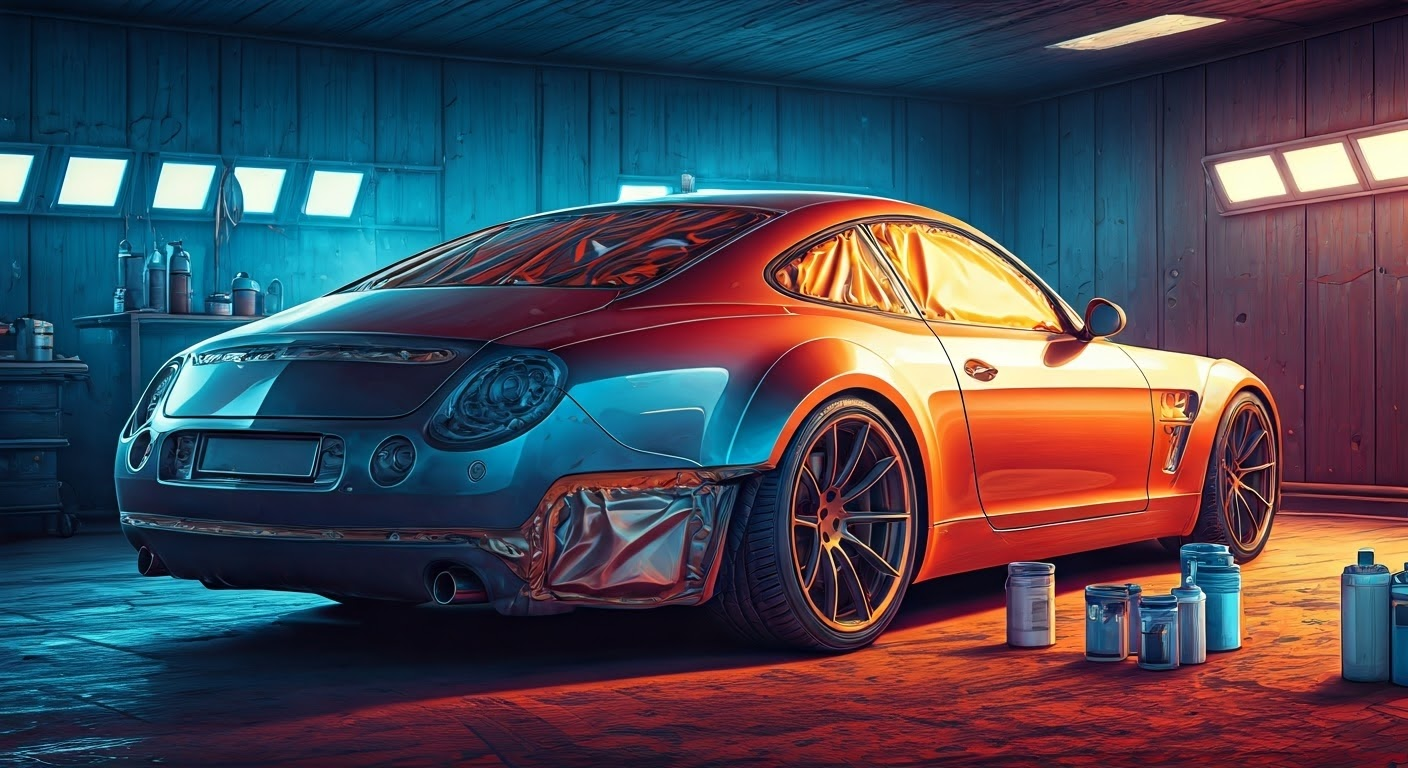
Embarking on a car painting project involves various considerations to achieve a flawless finish. Understanding the intricacies of how much paint is needed is crucial for a successful outcome.
Factors such as the size of the vehicle, the number of coats required, and the type of paint chosen all play a significant role in determining the amount of paint needed. Calculating the surface area to be painted, including the chassis, hood, and other components, is essential for an accurate estimate.
| # | Preview | Product | |
|---|---|---|---|
| 1 |

|
Rust-Oleum 334020 Painter's Touch 2X Ultra Cover Spray... | Check Price |
| 2 |

|
Carfidant Scratch Repair and Swirl Remover - Car Paint... | Check Price |
| 3 |

|
Rust-Oleum 7798830 Stops Rust Spray Paint, 12 oz,... | Check Price |
| 4 |

|
White Car Paint Touch Up Pen, Color Accurate Touch Up... | Check Price |
Understanding Paint Requirements for Your Car

Before heading off to buy your paint, it’s important to understand that there is no one-size-fits-all answer to the question of “how much paint?”. Several factors play a role in determining the precise amount needed for your specific car. The size of your vehicle is a major factor, as a larger SUV will naturally require more paint than a compact sedan.
Beyond size, the type of paint you choose also impacts the quantity required. Different paints have varying coverage capacities, impacting how much you’ll need for adequate coverage. Considering these variables ensures you buy sufficient paint, preventing potential shortages mid-project and saving you unnecessary trips to the store.
Factors Influencing Paint Quantities
Factors influencing paint quantities include the size of the vehicle, the type of paint used, and the number of coats required. Larger vehicles like trucks or SUVs will naturally require more paint compared to smaller cars. The type of paint, such as metallic or pearl finishes, may also affect the amount needed. Furthermore, applying multiple coats, including a clear coat, can significantly increase the overall paint volume necessary for a full and polished finish. Careful consideration of these aspects is essential for determining how much paint is needed to paint a car effectively.
Here’s a chart that details the estimated amount of paint required to paint various types of vehicles. This chart includes primer, base coat, and clear coat requirements to fully paint each type of car.
| Vehicle Type | Primer (quarts) | Base Coat (quarts) | Clear Coat (quarts) | Total Paint Needed |
|---|---|---|---|---|
| Motorcycle | 1 | 1 | 1 | 3 quarts |
| Compact Car (e.g., Hatchback) | 1.5 | 2 | 2 | 5.5 quarts |
| Sedan | 2 | 2.5 | 2.5 | 7 quarts |
| SUV | 2.5 | 3 | 3 | 8.5 quarts |
| Truck (Standard Pickup) | 3 | 3.5 | 3.5 | 10 quarts |
| Van (e.g., Minivan) | 3 | 4 | 4 | 11 quarts |
| Full-Size Vehicle (e.g., Large SUV) | 3.5 | 4.5 | 4.5 | 12.5 quarts |
Calculating Surface Area for Paint Application
Calculating the surface area of your car in square feet is a crucial step in determining how much paint you will need for a successful paint job. While you don’t need to be a mathematician to do this, having a rough estimate can be very helpful. There are a few methods you can use to calculate your car’s surface area accurately.
One convenient option is to use online car paint calculators that can provide you with an estimate based on your car’s make, model, and year. These tools simplify the process and give you a good starting point for determining the amount of paint required.
If you prefer a more hands-on approach, you can divide your car into distinct sections such as the hood, doors, roof, and bumpers. Measure the approximate surface area of each section in square feet and then add them together. Don’t forget to consider both sides of the car when making these calculations.
It’s important to note that these calculations are approximations, so it’s advisable to slightly overestimate the total surface area. This ensures that you have enough paint to cover your entire vehicle adequately and account for any potential errors or variations in application. By accurately estimating your car’s surface area, you can avoid running out of paint mid-project and achieve professional results.
How much paint is typically needed to paint a car?
It’s important to note that while a typical car may require approximately one to two gallons of paint, the actual amount needed can vary significantly based on several factors.
The size of the vehicle plays a crucial role in determining the quantity of paint required, with larger cars naturally needing more paint than smaller ones.
Additionally, the type of paint chosen for the job can also impact the amount needed. Some paints may provide better coverage and require less material, while others might need additional coats, increasing the overall volume used.
Moreover, factors such as the condition of the car’s surface, any existing paint layers that need to be removed or covered, and whether any intricate designs or patterns are involved can all influence the total amount of paint needed for a successful and satisfactory finish.
It’s always advisable to consult with a professional painter or refer to specific guidelines provided by paint manufacturers to ensure an accurate estimation tailored to your unique painting project.
What factors should be considered when determining the amount of paint required for a car?
When calculating the amount of paint required for a car painting project, several factors come into play to ensure a precise estimate and a successful outcome. The size of the vehicle is a primary consideration as larger vehicles naturally demand more paint for full coverage. Determining the desired paint coverage, whether it’s a single coat or multiple coats, is essential in estimating the quantity of paint needed accurately.
The type of paint application method chosen also influences the amount of paint required. Different methods such as spray guns, brushes, or rollers have varying paint consumption rates. Additionally, assessing any surface preparation needed, such as priming or sanding, impacts the final paint quantity calculation.
By taking these critical factors into account during the planning stages of a car painting project, you can ensure that you have sufficient paint on hand to complete the job without running out midway through. Proper estimation of paint quantities not only prevents delays but also helps in achieving a professional finish that meets your expectations.
Conclusion
In conclusion, understanding the amount of paint needed to paint a car involves various factors such as surface area, type of paint, and application method. By calculating these elements accurately, you can ensure a successful and satisfactory paint job for your vehicle. Remember to consider all aspects before beginning the painting process to avoid any inconvenience or lack of paint supply. Whether you are a DIY enthusiast or a professional auto painter, knowing how much paint to use is crucial for a smooth and efficient project. Feel free to refer to our FAQs for more detailed insights.
Frequently Asked Questions
How do I calculate how much paint I need for my car?
Calculating the amount of paint required for your car involves estimating the total surface area that needs to be painted in square feet. This can be done using an online paint calculator or by measuring and adding up the areas of various sections of the car manually. Once you have determined the total surface area, you can then proceed to calculate the amount of paint needed based on the coverage rate of the paint you intend to use.
It’s important to account for factors such as the number of coats you plan to apply and any additional areas that may require painting, such as bumpers or trim. Keep in mind that it’s always better to have a little extra paint on hand than to run out mid-project. By accurately estimating the amount of paint required, you can ensure a smooth and successful painting process for your car.
What factors should I consider when estimating paint quantity?
When determining the amount of paint needed to cover your car effectively, several crucial factors come into play. The size of your vehicle is a key consideration, as larger vehicles will naturally require more paint to cover their surfaces adequately. The type of paint you choose is also significant, as certain types may have different coverage capabilities and require varying application techniques. Additionally, the number of coats of color you intend to apply plays a crucial role in calculating the total quantity of paint needed. Each coat adds to the overall thickness and durability of the paint job, affecting the amount required for full coverage. By carefully considering these elements, you can ensure that you purchase a sufficient amount of paint to achieve a flawless finish on your vehicle.
How do I calculate the amount of paint needed to paint a car?
Calculate the total square footage (sq ft) of your car’s surface. Next, refer to your chosen paint’s coverage rate, usually provided per gallon or quart. Divide the total sq ft by the paint’s coverage rate to determine how many gallons or quarts you’ll need for a single coat.
